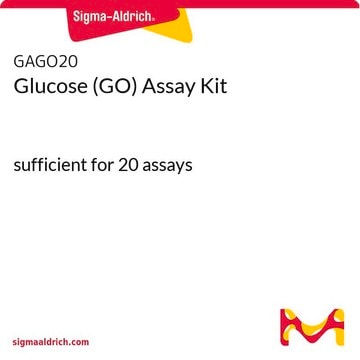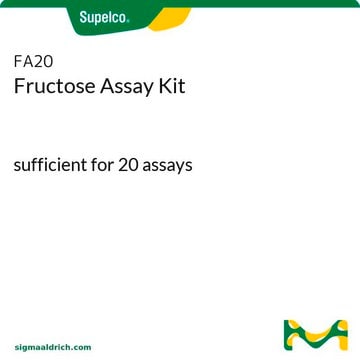The supplier advises that they have not yet validated any lysis buffers for use with cell samples in conjunction with this kit. Additionally, they recommend using an untreated, clear, flat-bottom plate for colorimetric measurements. Therefore, it would be preferable to transfer the samples to such a plate for running the assay.
MAK317
Sorbitol Dehydrogenase Assay Kit
sufficient for 100 colorimetric tests
Selecione um tamanho
Selecione um tamanho
About This Item
Produtos recomendados
método de detecção
colorimetric
doença(s) relevante(s)
endocrinological disorders, diabetes; gastrointestinal diseases
temperatura de armazenamento
−20°C
Categorias relacionadas
Descrição geral
Características e benefícios
Adequação
Princípio
Palavra indicadora
Warning
Frases de perigo
Declarações de precaução
Classificações de perigo
Eye Irrit. 2 - Flam. Liq. 3 - Met. Corr. 1 - Skin Irrit. 2 - STOT SE 3
Órgãos-alvo
Respiratory system
Código de classe de armazenamento
3 - Flammable liquids
Ponto de fulgor (°F)
75.2 °F - closed cup
Ponto de fulgor (°C)
24 °C - closed cup
Escolha uma das versões mais recentes:
Certificados de análise (COA)
It looks like we've run into a problem, but you can still download Certificates of Analysis from our Documentos section.
Se precisar de ajuda, entre em contato Atendimento ao cliente
Já possui este produto?
Encontre a documentação dos produtos que você adquiriu recentemente na biblioteca de documentos.
-
What are the recommended methods for homogenizing or lysing cells in a 96-well plate for the MAK317 Sorbitol Dehydrogenase assay kit? The manual advises against using proteolytic enzymes and suggests using a rubber policeman, which is not suitable for a 96-well plate. Are there any recommendations for a mild lysing buffer with minimal impact on the assay outcome? Additionally, is it possible and recommended to run the assay in the same 96-well plate, or is transferring the samples to a new plate necessary?
1 answer-
Helpful?
-
Active Filters
Nossa equipe de cientistas tem experiência em todas as áreas de pesquisa, incluindo Life Sciences, ciência de materiais, síntese química, cromatografia, química analítica e muitas outras.
Entre em contato com a assistência técnica








